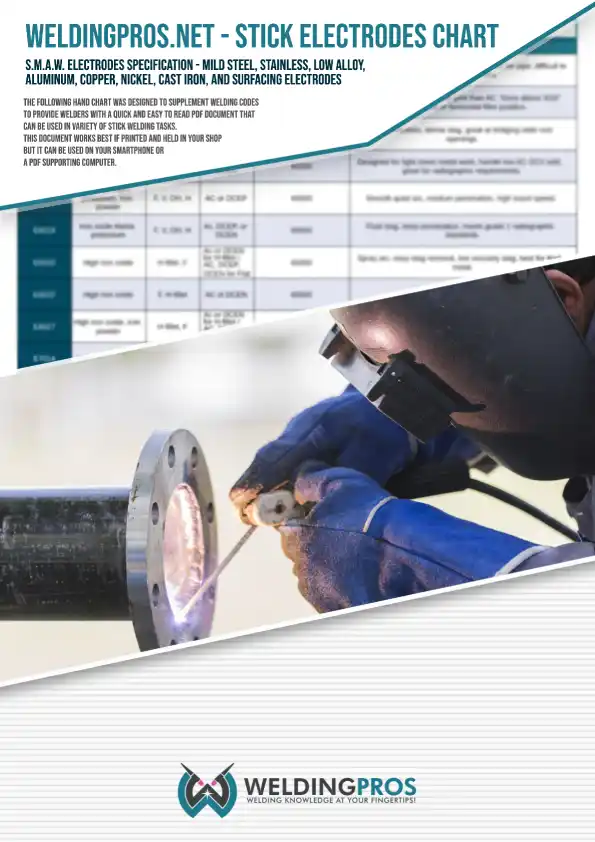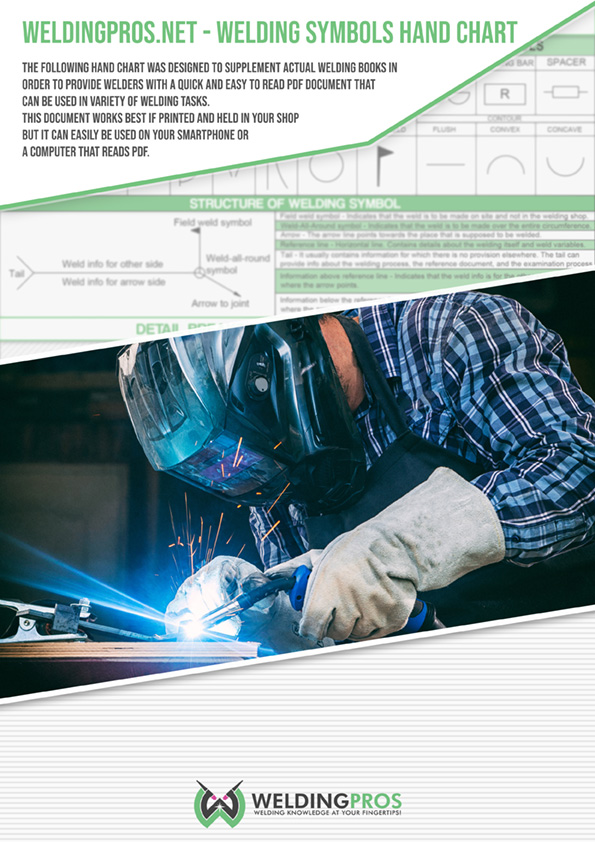Welding cable is the electrical conductor for the welding current. It consists of fine copper strands wrapped inside a non-conductive, durable jacket.
However, when it comes to welding cables, a common question that welders ask is;
What cable size do I need when welding at certain amps while being away from the power source?
![Welding Cable Sizes and Gauges - explained Thoroughly [2025] 1 Featured image for the welding cables sizes and gauges explained article](https://weldingpros.net/wp-content/uploads/2022/03/welding-cables-sizes-and-gauges-explained-1024x563.webp)
The problems that emerge are the audacity of ampacity, which directly impacts the size and construction of welding cables.
History of Welding Cables
Welding cable sizes and recommendations have been around for so long, but the first data dates to 1921 and the General Electric Company book. American Wire Gage (AWG) describes cable size, and the recommendations still stand today. The system is well defined and used by engineers all the time.
In 1928, at the start of the welding history “The Welding Encyclopedia” 2 stated the following: “When welding is done at great distances from the generator, the copper should be increased so that a drop in voltage across both leads (going and returning) should not be over 10 volts…”.
![Welding Cable Sizes and Gauges - explained Thoroughly [2025] 2 welding cable management](https://weldingpros.net/wp-content/uploads/2020/01/welding-cable-management-1024x768.jpg)
In 1936, the National Electrical Manufacturers Association (NEMA) published a “Recommended Practice.” It was the first welding cable standard you could find.
In 1938 the American Welding Society (AWS) published its first “Welding Handbook.” For the first time, the book showed recommended welding cables based on a 4 volt drop. The same table appeared in the second volume in 1942. These AWS cable recommendations were adopted in the first edition of the American National Standard Institute (ANSI) standard.
What Should You Know About Welding Cables?
As we noted at the beginning, a welding cable consists of a series of fine copper strands wrapped inside a type of synthetic or natural rubber of various colors. The copper is an excellent conductor, and the insulating jacket is designed to hold up to repeated movement.
Cable Ampacity
The ampacity, or amperage capacity, is the maximum amount of electrical current that the welding cable can conduct safely.
Different welding cables will have different amp ratings depending on several factors:
- cable length,
- wire size (gauge),
- resistance rating
Cable Length
When deciding the length, you should always opt for a cable that can reach every corner of your garage or welding shop. However, there is a catch.
When calculating the length of the welding cable, you should consider the entire welding circuit. Therefore, you should add the combined length of your electrode cable and the work cable.
Electrode cable connects your welding electrode source (TIG torch, SMAW electrode holder, MIG gun) and your welder. Meanwhile, work cable refers to your work clamp.
![Welding Cable Sizes and Gauges - explained Thoroughly [2025] 3 different welding cable length](https://weldingpros.net/wp-content/uploads/2022/03/different-cable-length.webp)
As a rule of thumb, shorter cables can withstand higher amperages than longer cables of the same diameter. However, increasing the length of the welding cable will result in a voltage drop. Thus, you will have to pick a thicker cable when increasing the distance.
Welding Cable Sizes – Gauge
So while being long enough, your cable must also be of appropriate size.
The cross-section of wires inside the cables usually is measured in circular mils. For example, one circular mil is the cross-section area of a wire with a 0.001 in. diameter.
Besides circular mil, you should be aware of circular mil foot.
For example, one circular-mil-foot of copper wire is 0.001 in. diameter and one ft. long. In addition, this wire will have a resistance of 10.37 ohms.
![Welding Cable Sizes and Gauges - explained Thoroughly [2025] 4 different welding cable sizes](https://weldingpros.net/wp-content/uploads/2022/03/different-circular-mill.webp)
To determine what wire size welding cable you need, you should know that as the current level increases, the diameter of the welding cable and cross-sectional area of the copper stranding needs to increase.
Therefore, you will have to match the amperage of the power to the proper cable size.
Electrical cables are typically categorized by an AWG (American Wire Gauge) size. For example, a higher number refers to a smaller diameter cable, while more prominent lines are labeled with 1/0, 2/0, and higher.
Here is an AWG table that can help you determine the size of the welding cable. Keep in mind that we represented the data up to 650 amps since you are less likely to work with higher-powered machines. Nonetheless, the AWG welding cable table represents cables that can conduct up to 1500 amps.
| Current (Amps) | Duty Cycle (%) | 0-50 ft. | 51-100 ft. | 101-150 ft. | 151-200 ft. | 201-250 ft. |
|---|---|---|---|---|---|---|
| 125 | 30 | 6 | 5 | 3 | 2 | 1 |
| 150 | 40 | 6 | 5 | 3 | 2 | 1 |
| 180 | 30 | 4 | 4 | 3 | 2 | 1 |
| 200 | 60 | 2 | 2 | 2 | 1 | 1/0 |
| 225 | 30 | 3 | 3 | 2 | 1 | 1/0 |
| 250 | 30 | 3 | 3 | 2 | 1 | 1/0 |
| 250 | 60 | 1 | 1 | 1 | 1 | 1/0 |
| 300 | 60 | 1 | 1 | 1 | 1/0 | 2/0 |
| 350 | 60 | 1/0 | 1/0 | 2/0 | 2/0 | 3/0 |
| 400 | 60 | 2/0 | 2/0 | 2/0 | 3/0 | 4/0 |
| 400 | 100 | 3/0 | 3/0 | 3/0 | 3/0 | 4/0 |
| 500 | 60 | 2/0 | 2/0 | 3/0 | 3/0 | 4/0 |
| 600 | 60 | 3/0 | 3/0 | 3/0 | 4/0 | 2 2/0 |
| 600 | 100 | 2 1/0 | 2 1/0 | 2 1/0 | 2 2/0 | 2 3/0 |
| 650 | 60 | 3/0 | 3/0 | 4/0 | 2 2/0 | 2 3/0 |
Thermal Resistance of the Cables
Copper is an excellent conductor of electricity, but it still has a degree of resistance to the flow of electrons through it. Thus, the wires will eventually start to heat.
While the copper wire can handle the high temperatures generated by welding current, the insulation protecting them will eventually melt. Insulation can be made of neoprene, EPDM, or PVC. Both neoprene and EPDM jackets are flexible resistant to harsh weather, abrasion, moisture, and water. However, they are not well suited for exposure to a gas or other petroleum-based liquid. PVC is less flexible but has high resistance to cuts and tears.
That’s why manufacturers often label a conductor temperature of 75°C (167° F), 90°C (194⁰F) or 105°C (221°F). So it is normal if your cable feels warm after prolonged welding. However, if your cable size cannot withstand the maximum amount of electrical current, the insulation will melt, eventually breaking a cable or even causing a fire.
Another factor that impacts the heating of cables is ambient temperature. Manufacturers usually rate the ambient temperature of lines of 30°C (86°F), but what does it mean?
If the ambient temperature is higher, the cables slightly lose their ability to dissipate heat. In addition, the same can happen if cables are tightly packed together. As a result, higher heat reduces the cable’s ampacity.
AWG Size Resistance (Ohms/ft)
| Gauge | Resistance (Ohms/ft) |
| 6 | 0.000394 |
| 5 | 0.000313 |
| 4 | 0.000249 |
| 3 | 0.000197 |
| 2 | 0.000156 |
| 1 | 0.000124 |
| 1/0 | 0.0000983 |
| 2/0 | 0.0000779 |
| 3/0 | 0.0000618 |
| 4/0 | 0.0000490 |
Duty Cycle and Polarity
Keep in mind that duty cycle nor polarity doesn’t affect the size of your cable.
Polarity determines how the current flows through the welding circuit, but it doesn’t affect the size of the cable. So as long as the line is thick enough to conduct electricity in the welding circuit, it doesn’t matter if the current polarity is set at DC+, DC- or AC.
Duty cycle refers to the time your can weld continuously within 10 minutes before taking a break. Each manufacturer tests the maximum duty cycle and expresses it in percentages, e.g., 30%-60%-100%. If you exceed the given period, the welder will overheat and shut down, so you will have to cool it off.
Remember that the duty cycle factor doesn’t directly impact the voltage drop. However, it will eventually heat up due to thermal resistance, so you should avoid using fragile cables.
Calculating Voltage Drop
As you can deduce from the previous text, many different factors can impact cable ampacity. However, using the oldest data and first books, experts found a way to calculate the voltage drop of the cable.
Knowing the resistance of a copper wire (10.37 ohm) and a circular mill of any wire, the voltage drop in any cable can be calculated using the following form:
V = (10.37) × (length in feet) × (current) / (circular-mils)
This calculation can be used today, and here is an example. At a table, We can see that the 2/0 cable has 133,075 circular mils. If a 150 ft long 2/0 cable should conduct 400 amps, using the formula:
V= (10.37) x (150) x (400) / (133,075);
We can say that the voltage drop is 4.67 volts.
Another way to calculate voltage drop in a cable is by using resistance-per-foot of various copper cable sizes instead of 10.37. Using these standard resistance figures eliminates the need to use division by circular mil.
You can read copper wire ohm/foot values from a table, or you can calculate it yourself by dividing resistance of 10.37 by circular mil value.
Therefore, you can use the following form to calculate the voltage drop:
- V = (ohms/foot) × (length) × (current)
For example, for 700 ft. long 4/0 cable at 100 amps:
- V = (0.0000490) × (700) × (100),
The cable will have a voltage drop of 3.4 volts.
Taking Care of Your Cables
Regardless of the size or length of your cables, if they are not properly maintained, they will underperform. That’s why keeping the welding cable and the cable connections in good condition is crucial.
Remember that cracks, cuts, worn spots, or other defects in the weld cable can decrease its current-carrying capability. In addition, you should keep your work clamp cable in top-notch condition as well. Any deficiencies can create a hot spot that will interfere with the welding current.
So if you have issues starting an arc and have already troubleshot everything else, pay attention to the cables. In addition to performance-related issues, worn lines are also hazardous. Overheating and melting insulation can cause a fire, so you make sure you immediately deal with potential hazards.
Sources:
- https://www.lincolnelectric.com/es-es/support/welding-solutions/Pages/selecting-proper-size-welding-cables.aspx
- https://temcoindustrial.com/product-guides/wire-cable-and-accessories/welding-cable#ampacity
- http://hyperphysics.phy-astr.gsu.edu/hbase/Tables/wirega.html
- https://www.powerstream.com/Wire_Size.htm
- https://www.weld.com/post/what-size-welding-cable-do-i-need
- https://forum.millerwelds.com/forum/welding-discussions/13905-welding-cable-lead-size-help





